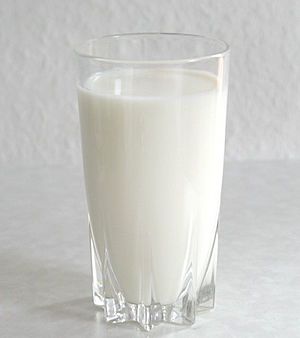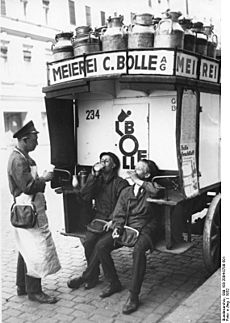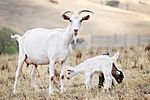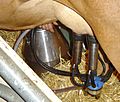Milk facts for kids
Milk is a white liquid made by mammals. This includes animals like cows, dogs, and humans. It is produced in special glands called mammary glands in female mammals. Newborn babies need milk because they don't have teeth yet. Milk helps them grow strong and healthy. It's also full of nutrients, especially calcium, which is great for your bones and teeth.
Contents
How to Keep Milk Fresh
If milk is not kept cold in a refrigerator, it will turn sour over time. This happens because of something called fermentation. Tiny living things called lactic acid bacteria change the sugar in milk into lactic acid. This process is also used to make other dairy products.
Milk is often pasteurised before people drink it. Pasteurization heats the milk to kill harmful germs. This makes it safer to drink and helps it last longer. After pasteurization, milk is made into things like cream, butter, yoghurt, ice cream, or cheese.
Pasteurised cow's milk will still go sour if it's not kept cold. Milk should be stored between 1° and 4° Celsius. If milk is heated to very high temperatures, it can last even longer without needing a refrigerator until it's opened.
What is Lactose?
Milk contains a natural sugar called lactose. Babies have a special enzyme called lactase in their bodies that helps them digest lactose. As people get older, they often make less lactase. If someone doesn't have enough lactase, they might have trouble digesting lactose. This is called lactose intolerance.
Many adults have lactose intolerance. There are medicines that can help them digest lactose. Also, many people who can't digest animal milk drink soy milk instead. Soy milk doesn't have lactose and tastes similar to animal milk, but it's made from soybeans.
How Do We Use Milk?
Milk is used in two main ways: as a natural food for baby mammals and as a food product for humans of all ages.
Milk for Baby Mammals
Almost all baby mammals drink milk from their mothers. This is called breastfeeding. Sometimes, the milk is collected and stored to be given later. The first milk from a mother is called colostrum. Colostrum is special because it has antibodies that protect the newborn baby from sickness. It also has important nutrients and things that help the baby grow. The type of colostrum and how long it's produced changes for different animals.
For humans, the World Health Organization suggests that babies only drink breast milk for the first six months. After that, they should continue breastfeeding along with other foods for at least two years. In some cultures, children are breastfed for three to five years or even longer.
Sometimes, fresh goat's milk is given to babies instead of breast milk. However, this can be risky for the child. It might cause problems with their body's chemicals, lead to a type of anemia, or cause allergic reactions.
Milk as a Human Food Product
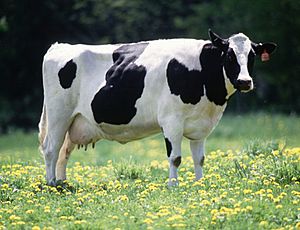
In many parts of the world, especially in Western countries, people continue to drink milk even after they are babies. They use milk from other mammals, like cows, goats, and sheep. Long ago, most adults couldn't digest milk because they didn't produce enough lactase. So, people would turn milk into things like curd or cheese to lower the lactose.
Thousands of years ago, a special change happened in some people in Europe. This change allowed them to keep making lactase as adults. This meant they could drink milk and use it as a new food source, which was very helpful when other foods were scarce.
Today, milk is processed into many different products. These include cream, butter, yogurt, kefir, ice cream, and cheese. Modern factories also use milk to make ingredients like casein, whey protein, lactose, condensed milk, and powdered milk.
Whole milk, butter, and cream have a lot of saturated fat. The sugar lactose is mostly found in milk. The enzyme needed to digest lactose, lactase, is highest in babies and then slowly decreases unless milk is consumed regularly. People who can digest milk as adults have found creative ways to use milk from many different domesticated animals. This includes not just cows, but also sheep, goats, yaks, water buffalo, horses, reindeer, and camels. India is the largest producer and consumer of cow and buffalo milk in the world.
| Country | Milk (liters) | Cheese (kg) | Butter (kg) |
|---|---|---|---|
| 135.6 | 6.7 | 2.4 | |
| 127.0 | 22.5 | 4.1 | |
| 105.9 | 10.9 | 3.0 | |
| 105.3 | 11.7 | 4.0 | |
| 90.1 | 19.1 | 1.7 | |
| 78.4 | 12.3 | 2.5 | |
| 75.8 | 15.1 | 2.8 | |
| 62.8 | 17.1 | 3.6 | |
| 55.7 | 3.6 | 0.4 | |
| 55.5 | 26.3 | 7.5 | |
| 54.2 | 21.8 | 2.3 | |
| 51.8 | 22.9 | 5.9 | |
| 49.1 | 23.4 | 0.7 | |
| 47.5 | 19.4 | 3.3 | |
| 39.5 | - | 3.5 | |
| 9.1 | - | 0.1 |
History of Milk Use
Humans started regularly drinking milk from other mammals after animals were domesticated. This happened during the Neolithic Revolution, when farming began. This change happened in different places around the world. It started as early as 9000–7000 BC in Mesopotamia.
The first important dairy animals—cows, sheep, and goats—were first domesticated in Southwest Asia. At first, animals were mainly kept for their meat. But later, people started using them for milk, hair, and work. Recent discoveries show that people were already milking animals in Southwest Asia by at least 7000 BC.
From Southwest Asia, domesticated dairy animals spread to Europe and South Asia. The first farmers in central Europe and Britain milked their animals. People who relied mostly on animals and their products, rather than farming crops, developed in Europe and spread across much of the Eurasian steppe. Camels, first domesticated around 4000 BC, were also used for milk in North Africa and the Arabian Peninsula.
In the rest of the world, like East Asia, the Americas, and Australia, milk was not a big part of the diet. This was either because people were hunter-gatherers who didn't keep animals, or their farming didn't include dairy animals. Drinking milk became common in these areas more recently, often because of European colonialism.
In the Middle Ages, milk was sometimes called "virtuous white liquor." This was because alcoholic drinks were often safer to drink than water back then.
Milk Production Becomes Industrial

As cities grew and railways expanded in the mid-1800s, milk production and supply changed a lot. Railway companies started moving milk from farms in the countryside to cities like London. By 1900, one company was transporting over 25 million gallons of milk each year.
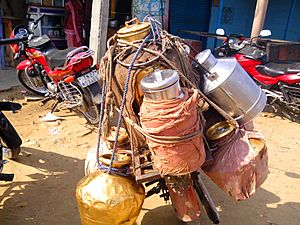
Demand for milk in cities grew because people had more money and milk was seen as a daily necessity. Laws in 1875 made it illegal to water down milk. This, along with marketing, helped improve milk's image. By the early 1900s, almost all milk in London came from rural areas by train. The milk supply system became very organized.
The first glass bottles for milk were used in the 1870s. An American inventor named Hervey Thatcher created a glass milk bottle with a waxed paper disk seal in 1884. Later, in 1932, milk cartons made of plastic-coated paper were introduced.
In 1863, a French scientist named Louis Pasteur invented pasteurization. This method kills harmful bacteria in drinks and food. He found that heating wine to about 50-60°C for a short time would kill microbes without ruining the wine. In his honor, the process was named "pasteurization." It was first used to stop wine and beer from going sour. Commercial pasteurizing equipment was developed in the 1880s.
Modern Milk Production
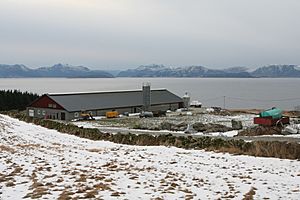
Today, the females of all mammal species can produce milk. However, cow's milk is the most common type produced for sale. In 2011, about 85% of all milk worldwide came from cows. Human milk is not produced or sold by companies. However, human milk banks collect donated human breastmilk and give it to babies who need it, such as premature babies or those with allergies.
In Western countries, cow's milk is produced on a very large scale. Most milk in developed countries comes from dairy farms using automated milking machines. Dairy cattle like the Holstein have been specially bred to produce more milk. About 90% of dairy cows in the United States and 85% in Great Britain are Holsteins. Other dairy cows include Ayrshire, Brown Swiss, Guernsey, and Jersey.
Other Animals That Provide Milk
Besides cows, many other animals provide milk for humans. These include buffalo, goats, sheep, camels, donkeys, horses, reindeer, and yaks. In 2011, buffaloes produced about 11% of the world's milk, goats 2%, sheep 1.4%, and camels 0.2%.
In Russia and Sweden, there are even small moose dairies.
American bison are not usually milked for commercial use. However, cows that are a mix of bison and domestic cattle can produce good milk.
Pigs are almost never milked, even though their milk is similar to cow's milk and safe for humans. This is mainly because milking a pig's many small teats is very difficult. Also, pigs can't store their milk like cows can. A few pig farms do sell pig cheese as a very expensive special item.
Coconut Milk: A Plant-Based Option
Coconut milk is not "real" milk because it comes from a plant, not an animal. However, it looks similar to animal milk because it is white. It also doesn't have as many nutrients as animal milk. It's made by taking the white "meat" from a coconut, squeezing it, and adding water. Coconut milk is often used in cooking, for example, in Thai curry.
Coconut cream is a thicker version of coconut milk, and it often has added sugar.
Why Milk is Good for You
Milk is an important part of a healthy daily diet. It has a lot of calcium, which helps make your bones and teeth strong. Milk also gives your body high-quality proteins and helps you get enough vitamins. Just one glass of milk can provide about 44% of the recommended daily vitamin intake.
However, some milk products do not have much calcium. These include cream, cottage cheese, ricotta cheese, and cream cheese.
Images for kids
-
Butterfat is a triglyceride (fat) formed from fatty acids such as myristic, palmitic, and oleic acids.
-
Returning reusable glass milk bottles, used for home delivery service in the UK
-
Vendors in Amritsar,India transporting milk in gagar, 2019
-
Four liter bagged milk in Quebec, Canada
-
A glass bottle of non-homogenized, organic, local milk from the US state of California. American milk bottles are generally rectangular in shape.
-
A rectangular milk jug design used by Costco and Sam's Club stores in the United States which allows for stacking and display of filled containers rather than being shipped to the store in milk crates and manual loading into a freezer display rack
-
Yakult, a probiotic milk-like product made by fermenting a mixture of skimmed milk with a special strain of the bacterium Lactobacillus casei Shirota
-
Gourd used by Kalenjins to prepare a local version of fermented milk called mursik
-
Steamed milk is used in a variety of espresso-based coffee beverages.
See also
 In Spanish: Leche para niños
In Spanish: Leche para niños


